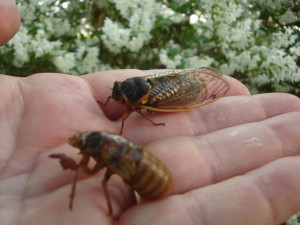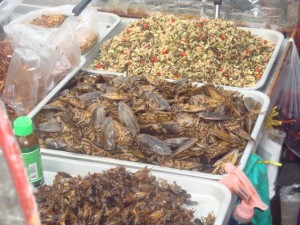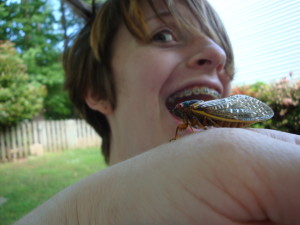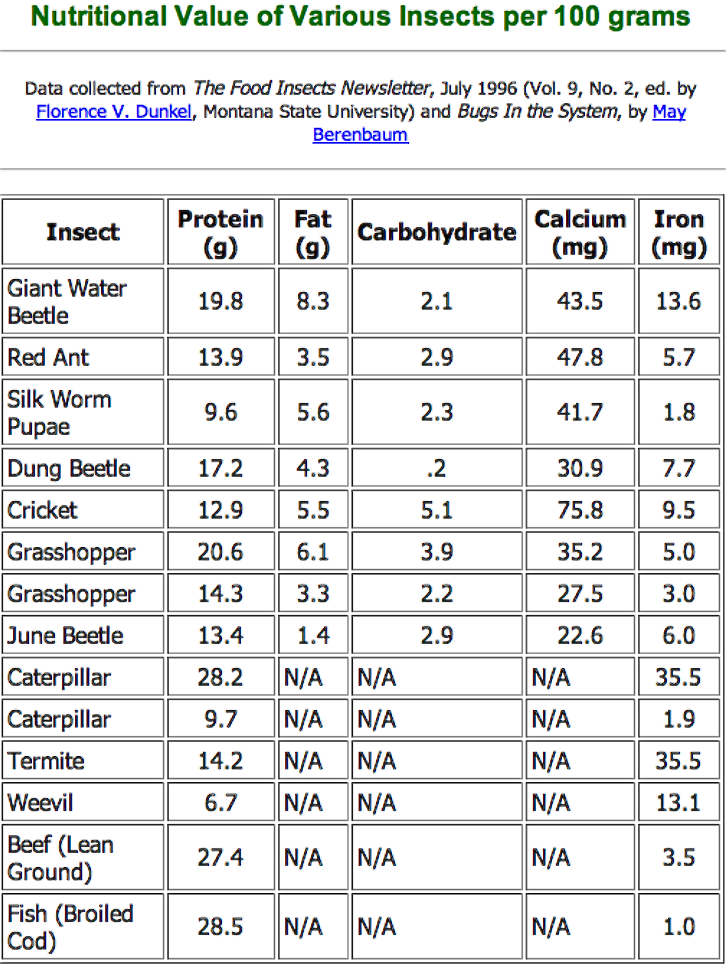by Leah, Momma Bear -
 We currently feel like we’re under attack from cicadas! This is the year when the so-called 17-year periodical cicadas emerge in the BILLIONS from northern Georgia to upstate New York. Our yard, here in Virginia, is littered with holes in the ground from the recently emerged larvae. Hundreds of larva husks are dangling from my bushes, and the red beady eyes from the newly sprung cicadas are staring back at us. The mating calls have not yet started, but they aren’t far off. What is a prepper to do with all these bugs? The answer: EAT THEM!?!
We currently feel like we’re under attack from cicadas! This is the year when the so-called 17-year periodical cicadas emerge in the BILLIONS from northern Georgia to upstate New York. Our yard, here in Virginia, is littered with holes in the ground from the recently emerged larvae. Hundreds of larva husks are dangling from my bushes, and the red beady eyes from the newly sprung cicadas are staring back at us. The mating calls have not yet started, but they aren’t far off. What is a prepper to do with all these bugs? The answer: EAT THEM!?!
 About 80% of the world’s population eats insects as a primary protein source. CNN recently reported, U.N.: Eat Insects, Save the World, that it has been hypothesized bugs are the future of food production due to their extremely low carbon footprint (compared to traditional proteins like chicken/beef/pork). Mass production of bugs for food does not pollute the environment, they are inexpensive to grow, and require very little space compared to the alternative proteins. Cicadas are just one of many edible insects, enjoyed throughout the world. Other common insects include meal worms, crickets, and water bugs (these look like giant cockroaches). These are all included on this photo I took of a “fast food cart” in Bangkok, Thailand, serving bugs for lunch.
About 80% of the world’s population eats insects as a primary protein source. CNN recently reported, U.N.: Eat Insects, Save the World, that it has been hypothesized bugs are the future of food production due to their extremely low carbon footprint (compared to traditional proteins like chicken/beef/pork). Mass production of bugs for food does not pollute the environment, they are inexpensive to grow, and require very little space compared to the alternative proteins. Cicadas are just one of many edible insects, enjoyed throughout the world. Other common insects include meal worms, crickets, and water bugs (these look like giant cockroaches). These are all included on this photo I took of a “fast food cart” in Bangkok, Thailand, serving bugs for lunch.
 Cicadas are definitely edible, and were eaten by early Native Americans. They are best harvested in the newly emerged larvae stage for the most tender eating, though they can also be eaten as the fully developed cicada, though they are much crunchier. Most insects are fried/sautéed. My kids voted that they would best be served with fried rice, that way they would be mixed in with other vegetables (and maybe they wouldn’t notice them so much). Interestingly, cicadas are a type of arthropod, which is the same category of food as shrimp and lobster. While I personally still prefer shrimp over cicadas, it is nice to know of another protein source that is literally right outside my door!
Cicadas are definitely edible, and were eaten by early Native Americans. They are best harvested in the newly emerged larvae stage for the most tender eating, though they can also be eaten as the fully developed cicada, though they are much crunchier. Most insects are fried/sautéed. My kids voted that they would best be served with fried rice, that way they would be mixed in with other vegetables (and maybe they wouldn’t notice them so much). Interestingly, cicadas are a type of arthropod, which is the same category of food as shrimp and lobster. While I personally still prefer shrimp over cicadas, it is nice to know of another protein source that is literally right outside my door!
[Trace’s note: I challenged Momma Bear to serve them for dinner, she responded that they wouldn’t be eating them anytime soon — but was glad to have additional options if necessary.]
Though it's not listed in this chart: gram of protein = 4 calories gram of fat = 9 calories gram of carbohydrates = 4So, for example, a Giant Water Beetle (pictured on the right) would provide 77.6 calories from protein, 74.7 calories from fat, and 8.4 calories of carbs; for a total of approximately 160 calories per 100 grams (3.5 ounces) of Giant Water Beetle.

